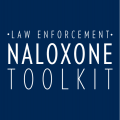Several options exist for providing training to law enforcement overdose response program participants.
One model is for the training to be provided by the staff of the local hospital, another health facility, health department, or EMS service. In these situations, the same medical organization often acts as a liaison for the naloxone supply. Some law enforcement agencies have an existing emergency response training infrastructure to maintain required first aid and first responder certifications. Depending on the organization’s internal capabilities, this training may be provided by a designated training officer, who often has additional medical training, or provided by staff of the external health agencies. Opioid overdose response training can be incorporated into this existing training infrastructure.
Another option is for a community-based organization providing naloxone access to members of the public to provide such training.
A third option is for the training to be organized at the state or county level using a distance learning or train-the-trainer model. E-learning tools may be especially useful for rural and tribal agencies.
By including presentations from law enforcement professionals in opioid overdose trainings, agencies can take advantage of the benefits of peer-to-peer learning, thus improving uptake and retention.
 As with any new initiative, officers should be trained in the proper handling and use of the medication. The length and content of the training are discretionary in most states. The vast majority of law enforcement overdose reversal programs are administered in collaboration with state or local departments of health, community-based organizations, healthcare organizations, or EMS agencies that provide officer trainings at no charge.
As with any new initiative, officers should be trained in the proper handling and use of the medication. The length and content of the training are discretionary in most states. The vast majority of law enforcement overdose reversal programs are administered in collaboration with state or local departments of health, community-based organizations, healthcare organizations, or EMS agencies that provide officer trainings at no charge.